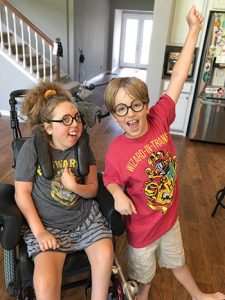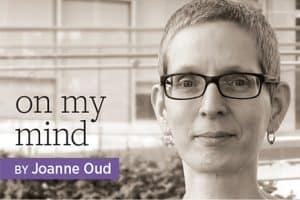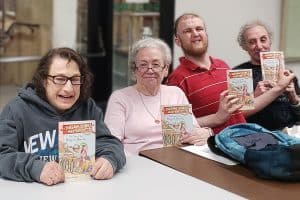
Before COVID-19 came along, 18-year-old Jack Miller, who has autism, visited the main location of Gail Borden Public Library District (GBPLD) in Elgin, Illinois, three times a week. On two of those visits, he dusted books, alphabetized DVDs, and performed other tasks as part of his school’s special-education vocational studies program; on the third, he came with his family to check out his favorite Impressionist art books and play games in the library’s computer lab—even though he has access to the same games at home.
“He is so routine-driven that he never considers doing ‘home’ things at the computer lab or ‘computer lab’ things at home,” says his mom, Rebecca Miller. “Being able to do these things at home is not the same to him at all.”
In addition, using the computer lab gave Jack a taste of what his mom calls “sheltered independence.”
“There are not very many places in the world you can go that are free, safe, and predictable, and a place to practice your independence skills as a young person with a disability,” she says.
The COVID-19 pandemic and its shifting limitations on GBPLD’s hours and services have taken a big toll on Jack and his family. So has the movement of his vocational studies program to an all-virtual model.
“I feel shocked about the changes at the library,” Jack says. “I feel confused. I miss my job.”
Since the pandemic began, GBPLD has at times reopened its buildings with social distancing measures and mask requirements, but Miller’s routine has not resumed. Even in periods when the main location has been open, its computer lab has mostly remained closed—so his family has taken him to a branch location instead, to avoid the distress he might feel upon seeing his familiar computer lab without being able to use it.
“Mom and Dad make me go to the little library [branch] because of COVID-19,” Jack says. “I like the little library, but I like the big one better.”
Of course, it would be difficult to find a library-goer whose visits haven’t been affected by COVID-19. But for Jack and many other people with disabilities, the effects are reaching even further. Losing independence, socialization, cognitive stimulation, and other library benefits is, in many cases, leading to emotional, intellectual, and other difficulties.
“Not being able to go to the library has made Jack very sad,” his mother says. “It adds to his confusion and fear right now.” She adds that even in non-pandemic times, “large parts of the world don’t make sense” to him, so having one of his comfort zones removed is significant. “Not only does he miss that comfort zone, he begins to question all his other comfort zones,” she says. “For example, every time his dad takes the dogs for a walk, Jack exclaims ‘You came back!’ when he returns. I see him losing confidence in what he thought were rules and predictable things in the world.”
Service slowdowns
Another thing rendered less predictable by the COVID-19 pandemic: the ease and speed with which people with low vision or blindness (or other physical disabilities that prevent them from reading or holding a printed page) can access braille and audio materials from the National Library Service (NLS) for the Blind and Print Disabled’s free service by US mail.
For decades, NLS has made books and magazines in braille and audio formats available to patrons who qualify, along with devices needed to read or listen to them. NLS relies on a national network of about 100 partner libraries, as well as two warehouses stocked with talking-book machines and other resources, plus an app called Braille and Audio Reading Download (BARD), to circulate materials to about 350,000 users. Parts of that service experienced slowdowns in 2020.
While the year saw much media coverage of mail delays caused by the US Postal Service, delays related to NLS materials came about primarily because of local, COVID-related restrictions affecting NLS’s partner libraries, says Kristen Fernekes, NLS head of communications and outreach: “Starting in mid-March, it was hard to keep up.”
Some libraries that closed to the public because of COVID-19 found that with staff members working from home, they couldn’t receive or send out shipments of braille or talking-book materials. At one California library, staffers who would normally download audio files onto special cartridges for patrons to use with NLS-lent playback machines instead took the cartridges home with them and downloaded the files there for distribution.
In addition, one of NLS’s two warehouses was forced to close for several months because of COVID-19. Fortunately, the other warehouse remained open, and NLS staffers were able to hastily rework processes so that patrons whose libraries had closed were able to receive materials directly from the warehouse instead. “Some of our libraries were able to work remotely and receive messages from their patrons, and then everybody worked together to get them stuff,” Fernekes explains.
We hear all the time that our materials are lifelines for our patrons. We take that very seriously.—Kristen Fernekes, head of communications and outreach, National Library Service for the Blind and Print Disabled
Even in non-pandemic times, many NLS users experience isolation because of age, ability, and health status. “We hear all the time that our materials are lifelines for our patrons,” Fernekes says. “We take that very seriously.” That’s why, she says, as soon as the pandemic’s ramifications for NLS services became clear, “the staff at NLS and the folks we were talking to from our network libraries immediately went into the mode of: ‘We’ve got to figure out some way to get this to work.’”
For example, NLS asked partner libraries to train as many users as possible on BARD. NLS-registered patrons can, after contacting their local library to receive login credentials, download BARD and use it to transfer NLS catalog items onto a smart device. In some cases that means downloading a braille file and syncing it to a device that features a refreshable braille display; in others, it means downloading an audio file onto a cartridge for use in a talking-book machine.
The push to increase BARD use did help, Fernekes says, though she’s not sure by how much. She notes that people who would not have otherwise taken the leap to try BARD saw it as “a pretty good alternative” and that some partner libraries reported seeing “very significant increases” in the number of users.
But, she says, some patrons prefer to read hard-copy braille content instead of using BARD. “I’m afraid that those people were probably the ones who were the most impacted as far as getting materials,” she says. The lengthy process of transcribing and maintaining quality of that content is done by outside vendors, she says, and many of those vendors shut down because of the pandemic.
Despite any service delays they may have encountered, NLS users have continued to send messages of gratitude to the service and its partner libraries, like this one from an anonymous patron: “I really wish to express my appreciation for what you and your colleagues have been doing for me these past years. I have been an avid reader all of my life, so when my vision dimmed, I was devastated. The Talking Book program has been a true blessing! In these perilous times I really appreciate your willingness to continue working.”
The vagaries of going virtual
The pandemic has also pushed much in-person library programming online. For some patrons with disabilities, that change represents a mixed bag.
One of the groups that has gone all-digital as a result of the COVID-19 pandemic is the Next Chapter Book Club (NCBC) at Nevada County (Calif.) Community Library’s Truckee branch. As part of the national NCBC program, the club gives people with developmental and intellectual disabilities the chance to gather, read, and discuss books. When the branch halted its in-person services in March 2020, the book club began meeting online with the assistance of staffers from local nonprofit Tahoe Ability Program (TAP), who help promote and facilitate the club among TAP clients and distribute the chosen books to participants.
Bobbi Luster, Truckee branch manager, says the club still serves as a “bright spot” for the 10–15 members who continue to attend.

“Our patrons with special needs, who are unable to drive and depend on others to assist them, have been extremely isolated,” she says. “For example, some of our patrons who live in care facilities were in lockdown for extended periods of time, not allowed to leave the facility or have guests visit them. Virtual convenings, like book clubs, were some of their only outlets for social connections.”
Participant Erin Freeman agrees. While Zoom is “not the same as in person,” she says, she still calls it “a good way to do book club” and says that being able to virtually attend has helped ease the isolation of the pandemic for her: “I’m a social person. I miss all my friends.”
For others with disabilities, the new online format may make participation limited or even impossible, says TAP Program Manager Mariah O’Shaughnessy. She points out that some of the people her organization serves have limited verbal abilities and that “some clients struggle to comprehend what may be happening in the story or become lost on where they are within the book.” An in-person setting would permit her or another staffer to attend meetings “to explain on the side and help people feel involved,” she says. Whereas now, “I’m not there [in the room] with people. Overall, it’s a huge loss.”
Children with disabilities
Before the COVID-19 pandemic shutdowns, Arlington (Tex.) Public Library (APL) hosted a weekly play group for children with disabilities, featuring stories, songs, and activity stations. Five-year-old Hannah Garcia, who was born with Down syndrome, attended regularly. “It was a safe environment for her to go, where she could be herself and play and interact, where she was accepted for who she is and for the attention span she has,” says her mother, Nora Garcia.
Once the pandemic made in-person programming impossible, the play group’s creator, librarian Ashley Faith Wyche, converted it to a virtual format. “I think that by going virtual, my disability programming has been able to reach a more widespread audience,” Wyche says. “Additionally, I think that even when we feel like [it might be safe] to do in-person programs, this audience is so high-risk that they may still delay coming in. So for situations like that, I think that virtual programming is a lifeline.” Wyche has since left APL for a position at Grand Prairie (Tex.) Public Library System, where she plans to continue the virtual play group.
Despite the virtual group’s benefits, Wyche acknowledges, “I think all of us—families, children, and staff alike—are missing that in-person communication and sense of community.”
Garcia and her daughter certainly are. While they’ve given the virtual playtime a shot, Garcia says Hannah is missing out on the benefits of modeling the behavior and language of her peers in a group environment. “For somebody like Hannah, it’s not the same,” she says.
The disruption in their library routine, along with interruptions to Hannah’s schooling and therapy, has resulted in some regression of life skills, as well as an increase in anxiety. Even with some library access now allowed, Garcia doesn’t feel safe taking Hannah there, since her daughter won’t wear a mask for more than a minute.
Pre-pandemic, Erin Ozment frequented two branches of Orange County (Fla.) Library System (OCLS) in Orlando, with her 13-year-old daughter, Elena, who uses a wheelchair, has visual impairments, and is nonverbal.
There Elena enjoyed checking out books in her favorite genre—fantasy—and occasionally participating in arts and crafts programming. Her younger brother took advantage of the library’s free classes, which allowed Ozment to spend valuable one-on-one time with Elena in other parts of the building.
Since Elena’s medical issues put her at high risk for COVID-19, the family now relies on an OCLS service that allows patrons to receive materials by mail. While grateful for that, Ozment says not being able to visit the library has taken a toll on Elena’s state of mind. “I know she loves me, but she’s tired of not seeing other people. The library is part of that,” she says. “Having a welcoming place with other people is important. It’s just been a huge reminder of how integral libraries are—for my family in particular.”


